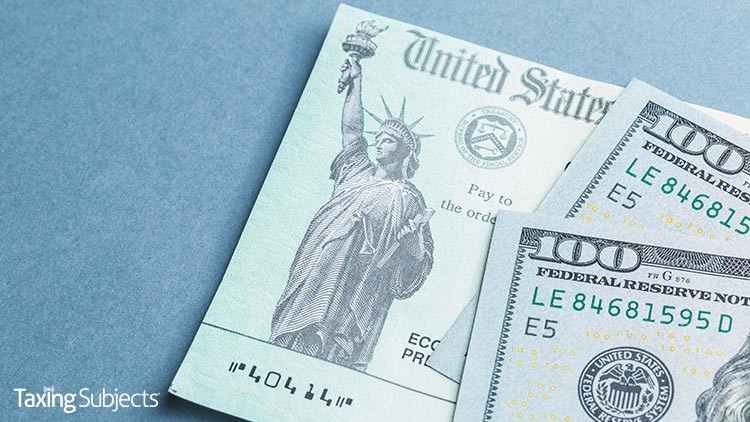
Employees of three federal agencies are keeping very busy these days, sending out the millions of Economic Impact Payments (EIPs) to Americans in need.
The Internal Revenue Service, the U.S. Department of the Treasury, and the Bureau of the Fiscal Service have disbursed more than 130 million total EIPs as part of the American Rescue Plan.
The payments sent so far are worth an estimated $335 billion. More are on the way.
As announced on March 12, Economic Impact Payments continue to go out in batches to millions of Americans.
This third batch of EIPs began processing on Friday, March 26, with an official payment date of March 31. Some individuals got direct payments in their accounts earlier, showing as “provisional” or “pending” deposits.
The IRS has more information about the payments so far:
- This batch includes the first of ongoing supplemental payments for people who earlier in March received payments based on their 2019 tax returns but are eligible for a new or larger payment based on their recently processed 2020 tax returns. These “plus-up” payments could include a situation where a person’s income dropped in 2020 compared to 2019, or a person had a new child or dependent on their 2020 tax return, and other situations.
- The most recent payments announced also include payments for people for whom the IRS previously did not have information to issue a payment but who recently filed a tax return and qualify for an Economic Impact Payment. Payments to this group—and the “plus-up” payments noted above—will continue on a weekly basis going forward, as the IRS continues processing tax returns from 2020 and 2019.
- In total, this third batch includes more than 4 million payments, with a total value of more than $10 billion.
- This batch of payments contains more than 2 million direct deposit payments (with a total value of more than $5 billion) and approximately 2 million paper check payments (with a total value of nearly $5 billion).
In the first two batches of payments, which started processing on March 12 and March 19, payments were mainly sent to eligible taxpayers who filed 2019 or 2020 tax returns.
Those people who don’t typically file a return but successfully used the Non-Filers tool on IRS.gov last year were also included in these first two batches, getting a direct deposit, paper check or prepaid debit card.
Another large batch of payments will target recipients of Social Security and other federal benefits who didn’t file a 2020 or 2019 tax return and did not use the Non-Filers tool last year.
These payments are going to Social Security retirement, survivor or disability (SSDI), Supplemental Security Income (SSI), and Railroad Retirement Board (RRB) beneficiaries. As announced previously, these payments will begin to be issued immediately, with the expectation that most of these payments will be sent electronically on April 7.
No action needed by most qualifying Americans
While no action is needed by most people to get this round of Economic Impact Payments, they can check the Get My Payment tool on IRS.gov to see if their payment has been scheduled.
Prospective recipients need to be patient in checking if their payment is on the way. The IRS notes that the Get My Payment tool won’t be updated with the latest information until the weekend of April 3-4.
The IRS is reviewing data for Veterans Affairs (VA) benefit recipients and expects to have a payment date and other details soon.
At present, the IRS estimates Economic Impact Payments for VA beneficiaries who don’t regularly file tax returns could be sent out in mid-April.
VA beneficiary payment information, the agency says, will be available through the Get My Payment tool, although no date has been mentioned.
What about non-filers?
Some federal benefits recipients may need to file a 2020 tax return—even if they don’t usually file. Filing gives the IRS the information it needs to send payments for qualified dependents. Those eligible who fall into this group should file a 2020 return as soon as possible in order to be considered for an additional dependent payment.
People who don’t normally file a tax return but don’t get federal benefits may still qualify for an Economic Impact Payment. This includes the homeless, the rural poor and others.
For those who didn’t get a first- or second-round EIP—or got less than the full amounts—they may be eligible for the 2020 Recovery Rebate Credit, but will need to file a 2020 tax return to get it. The special section on IRS.gov, Claiming the 2020 Recovery Rebate Credit if you aren’t required to file a tax return, can help.
The third round of Economic Impact Payments differs from the other two rounds in that income levels have changed from the previous payments. Some people won’t be eligible for this third payment even if they got one or both of the previous EIPs or claimed a 2020 Recovery Rebate Credit.
Payments will begin to be reduced for those making $75,000 or above in Adjusted Gross Income ($150,000 for married filing jointly). The payments end altogether at $80,000 for individuals ($160,000 for married filing jointly); people with Adjusted Gross Incomes above these levels are ineligible for a payment.
Additional information on Economic Impact Payments is available on IRS.gov.
Source: IR-2021-72

 Ameritax
Ameritax